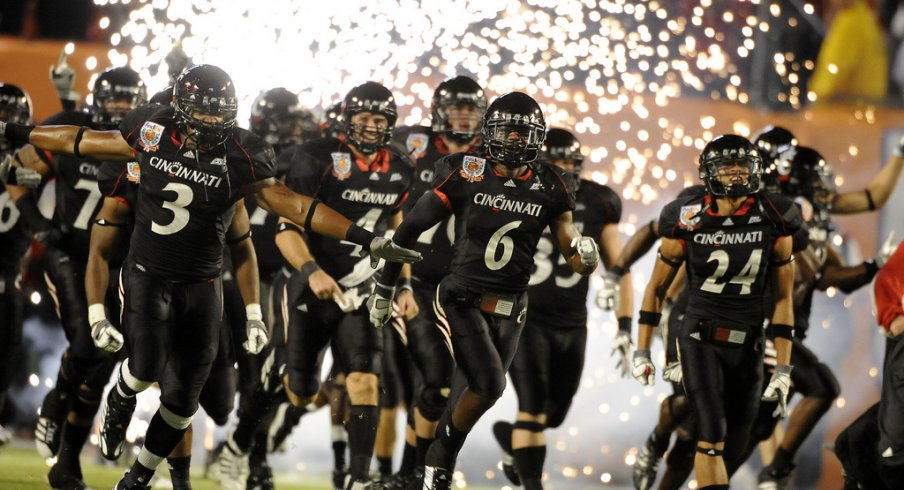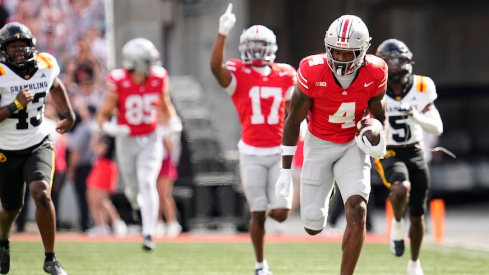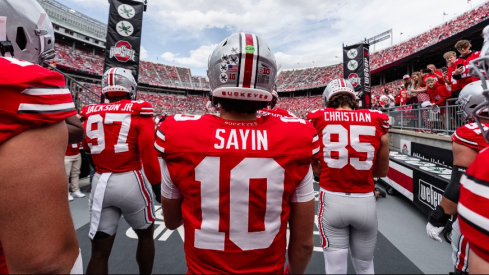October 8, 1921. It’s a date that probably doesn’t resonate with many people. There’s little significance to it. The United Kingdom and Ireland held a peace conference and the silent film “The Sheik” premiered.
In Cleveland, the eighth of October marked the first Sweetest Day, a holiday concocted by a group of candy makers. Some two hours southwest of Cleveland, the day was anything but sweet for Ohio State. The Buckeyes went to Ohio Field that afternoon and were upstaged by in-state foe Oberlin, 7-6.
Since that day, Ohio State’s played 38 games against schools from the state of Ohio and won every single one of them. It will have a chance to extend that streak to 40 this season, as both Cincinnati and Kent State invade Ohio Stadium. But is that number in danger of falling?
Tommy Tuberville’s Bearcats have the most realistic shot of beating the Buckeyes since Toledo in 2011, when it nearly defeated a downtrodden Ohio State group in a season mired by controversy. After a 47-year gap between bowl appearances, Cincinnati’s been to 12 bowl games since 1997.
Still, UC lags behind Ohio State on a consistent basis. The Bearcats nearly played for the 2008 national championship, but aside from that, the Buckeyes’ name brand, tradition and financial power has kept it on a pedestal above all in-state comers. Cincinnati has tried desperately to become a member of a Power Five conference, with the ACC being its main target, to no avail.
For nine seasons, from 2005-2013, Cincinnati enjoyed its BCS-conference status. It came to an abrupt halt after last season. Now, the Bearcats find themselves in the ramshackle American Athletic Conference. Membership includes college basketball national champion Connecticut, but football rules all negotiations in college sports, and the AAC has little muscle to flex.
Cincinnati and UConn are arguably the most attractive schools that didn’t get plucked during the realignment craze. When the ACC raided the Big East, Louisville, Syracuse and Pitt were chosen, leaving Cincinnati and UConn licking their wounds. Many believe UConn and even Syracuse were more viable for the Big Ten than Rutgers. As it stands, the Bearcats and Huskies speak in glowing terms about the AAC, while trying to wiggle their way out of the league behind closed doors.
Cincinnati president Santa Ono memorably sent holiday cards to ACC presidents to highlight the Bearcats’ desire to play in the conference.
Instead of splitting $90-$100 million dollars in a Power Five conference, Cincinnati is dividing somewhere in the neighborhood of $20 million. In the financially driven world of college sports, that’s the margin between the Haves and Have-nots.
After athletic director Whit Babcock left for Virginia Tech, Cincinnati brought in former Colorado AD Mike Bohn, who helped lead the Buffaloes from the Big 12 to the Pac-12. His top priority immediately became charting a similar course for the Bearcats.
Ironically, the Big 12 is Cincinnati’s best landing spot at this point, the conference Bohn worked so hard to get Colorado out of. The league has only 10 members and West Virginia is isolated from all other schools.
“Do we aspire like other members of the league? Yes, of course. But I think we have a lot of work to do,” Bohn said. “We don’t know where our current league could expand and grow. We need to be mindful of that and be a national leader in helping pull those things together. Our first priority is to win conference championships in the league we’re in, respect the league and build the league, and all those other things will take care of themselves.”
The aim becomes winning and doing what it can with money. Cincinnati’s athletic department will receive a hefty payment from exit fee funds from schools that left the league. There’s also hope of being the highest-ranked team outside the Power Five, which comes with a $6 million payday. The top conference gets an additional $7 million.
“We want to be strong supporters of our league and work on winning conference championships and work on developing that brand and conference,” Bohn said. “We can’t control the national landscape, but we understand we want to compete at the highest level. We can compete at the highest level in this conference. There were five ranked teams in men’s basketball. Cincinnati’s proven it can be in marquee bowl games. We need to take advantage of that and compete and make major strides in the league we’re in.”
Cincinnati wasn’t left out because of location. The city is enjoying a revitalization and its size is attractive. Where the university falls short is a lack of football tradition and its venue is old and small – Nippert Stadium, capacity 35,000, was built in 1915.
Ohio State’s never faced a big school roadblock in its own state. Cincinnati as an ACC or Big 12 member could impact the Buckeyes’ stranglehold on top talent in the state. Ohio State’s never been an overwhelming destination for Cincinnati-area kids, which is one reason why Urban Meyer moved the 2013 spring game to Paul Brown Stadium. But the Bearcats also haven’t been a pipeline for the best players from St. Xavier, Moeller, Elder, Colerain, etc.
If their opponents included the likes of Notre Dame, Florida State, Miami and Virginia Tech, college destinations may change. When Cincinnati was previously in a BCS conference, Ohio State enjoyed tremendous success. A falloff would not occur if the Bearcats played in a more attractive league.
Ohio’s talent is too plush and the Buckeyes will always be the top choice of most kids growing up in the state. Fifty years down the road, a shift could happen. But Cincinnati’s program as a legit threat to the Buckeyes is still in its infancy. Michigan and Michigan State, USC and UCLA, and Florida, Florida State and Miami have been well-established programs for decades.
But Cincinnati’s recent success is nothing to ignore. During the BCS era, it played in more BCS games than seven SEC schools and was one of 30 schools to play in multiple BCS games (2009 Orange Bowl, 2010 Sugar Bowl). The Bearcats have won or shared four conference titles in the past six years, more than Ohio State and tied for the most in the country during that span.
If you glance at Cincinnati’s head-coaching names and notice the last four read Mark Dantonio, Brian Kelly, Butch Jones, Tommy Tuberville, it all begins making sense. Tuberville left Texas Tech, a Big 12 school with a clear path to the playoff, for Cincinnati, where uncertainty is the only thing that’s certain.
It acts as a coming home of sorts for him with his wife being from just across the Indiana border. And good deeds have already taken place – Tuberville donated $300,000 of his salary to help out Olympic sports at UC.
His own resume is even more impressive than Cincinnati’s recent run. Tuberville was an assistant on three Miami national championship teams, he was the defensive coordinator in 1994 for Texas A&M’s undefeated team and led Auburn to an undefeated season in 2004.
For now, Cincinnati will just concentrate on winning football games. Especially the one played on Sept. 27.


